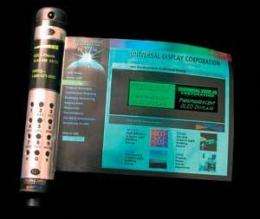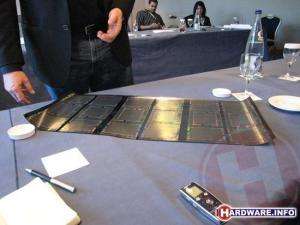March 25, 2010 weblog
HP Demos Rollup Flexible Displays (w/ Video)

(PhysOrg.com) -- The Flexible Display Center, at Arizona State University, hopes to have flexible displays ready for test trials in approximately three years. The possibilities of using flexible displays are endless and one day will be used in many portable devices such as e-readers, cell phones, and tablets.
The people at hardware.info recently saw one of HP’s flexible screens rolled up and placed into a poster tube. HP’s CTO, Phil McKinney states that the flexible display is not designed to be rolled up. The display would only survive being rolled up about six times before it would start to malfunction. The screens are printed on flexible plastic sheets of Mylar material and could be easily rolled during the manufacturing process.
The displays can be mass produced by using a production method called Self-Aligned Imprint Lithography (SAIL). By manufacturing the displays in the form of rolls instead of sheets makes the production method more cost effective.

HP’s manufacturing process, for the prototype, allows for the fabrication of thin film transistor arrays on a flexible plastic material. The displays would then be created using a roll-to-roll manufacturing process in a similar way like a newspaper is printed in the press. This compares to the current method used today as a batch process where displays are cookie cut.
Carl Taussig director of Information Surfaces at HP Labs stated, “In addition to providing a lower-cost process, SAIL technology represents a more sustainable, environmentally sensitive approach to producing electronic displays. We want to lower the costs of traditional flat panel displays and increase their functionality.”

HP is hoping to use this technology to offer lighter and more compact devices such as e-readers and tablets. The head of HP technology is expecting, in about two years, to have the first products on the market and in about three years to have mass production.
More information:
flexdisplay.asu.edu/
via HardwareInfo
© 2010 PhysOrg.com
















